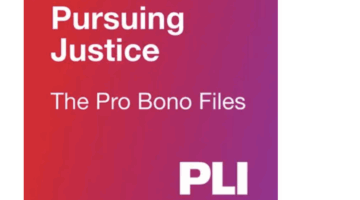
Mike Quartararo
Ed. note: Please welcome our newest columnist, Mike Quartararo, a former law firm director, well-known legal technologist, an author, educator, a veteran of the legal industry, and now the managing director of his own consultancy, eDPM Advisory Services. He will be writing about legal operations.
One of the things that has always puzzled me is how some of the smartest people in the world could behave so irresponsibly when it comes to legal matters. I’m not a lawyer, and granted, I’ve worked around lawyers long enough that some of their tendencies if not their practices have probably rubbed off on me, but even I know what is required when it comes to preserving documents and electronically stored information (ESI) in the context of discovery.

Chrometa: Turning Time Into Billable Value For Modern Lawyers
Adoption of Chrometa represents more than a technological upgrade; it reflects a professional philosophy that values accuracy, transparency, and efficiency.
This is not a new thing.
Judicial rules governing the preservation of documents in discovery existed long before anyone ever thought about producing electronic documents. The notion that parties to a litigation need to preserve for discovery potentially relevant evidence should not strike any lawyer in the U.S. as unheard of or novel. But that is exactly what appears to have happened in Small v. University Medical Center, No. 2:13-CV-0298, an August 14 court decision from the United States District Court for the District of Nevada. And while this court decision reads like an indictment of counsel who represented University Medical Center (UMC), in fairness the client here is not without fault and that is why legal operations personnel need to pay attention here.
The best example of the worst example?
The Small case revolves around claims against UMC for unpaid wages and overtime. On its surface, it’s a pretty straightforward employment litigation. In fact, it matters not what the claims in the case are; this could involve any dispute. What is so striking is not the plaintiff-employee claims — these kinds of cases crop up all over the country. No, what surprised me is the abject failure of UMC to take even the most rudimentary steps to preserve electronic documents, to implement a litigation hold, and to comply with basic rules and norms of discovery in litigation.

Pursuing The Pro Bono Story: A Conversation With Alicia Aiken
This Pro Bono Week, get inspired to give back with PLI’s Pursuing Justice: The Pro Bono Files, a one-of-a-kind podcast hosted by Alicia Aiken.
You should not take my word for it. Here’s what the judge said after reciting the litany of complaints, the numerous discovery conferences, motions to compel, and hearings before and after appointing a special master in an effort to reign in the discovery abuses:
“The record before the court and the record developed by the special master amply supports his findings that UMC destroyed evidence by failing to identify, preserve, collect, process, and search multiple repositories of information relevant to the parties’ claims and defenses.”
* * * *
“There is no question UMC failed to implement a timely litigation hold and failed to communicate its legal preservation duties to key custodians of discoverable evidence. There is no question that UMC failed to preserve discoverable ESI. There is no question data was lost or destroyed as a result. There is no question sanctions are warranted. UMC concedes they are. The only question is what sanctions are appropriate and proportional for the violations.”
To summarize, the court found that:
- UMC had no preservation or litigation hold policy;
- UMC failed to properly notify custodians of the duty to preserve relevant information;
- UMC failed to timely implement a litigation hold;
- UMC executives were unaware of their preservation duties, ignored them, or addressed them “in the hallway in passing”;
- Counsel for UMC failed to conduct timely custodian interviews;
- UMC failed to suspend business as usual to prevent the destruction, deletion, or modification of electronic documents;
- UMC modified, lost, deleted, or destroyed ESI responsive to plaintiffs’ discovery requests; and
- UMC failed to comply with court orders to preserve and produce ESI.
And as if to somehow emphasize the point, the judge found that the key custodians at UMC did not even preserve the belated preservation letters they received from original defense counsel in the case.
On the bright side…
The good news is that the court did not impose dispositive sanctions and enter a default judgment against UMC. Instead, the court opted to apply the more spoliator-friendly 2015 version of Rule 37(e) of the Federal Rule of Civil Procedure and ordered as sanctions merely an adverse jury instruction and monetary fines.
The court’s opinion exceeds 65 single-spaced pages. The table of contents was three pages long. It was at times hard to read, and I’m sure that there is more to the story than is reported in the court’s decision.
But the point is that there’s a lesson here for corporations — for all organizations, for that matter. What’s the lesson? If you need to be told that your organization or your client has an obligation to preserve documents and ESI once it is known that a lawsuit has been filed, or that you need to implement a litigation hold and not destroy, delete, or alter documents, you may want to consider another line of work. They do teach at least this much in law school.
A little help from our friends?
Beyond that, if you lack the technical competence or you are overwhelmed by all this talk of eDiscovery, then your obligation is to either learn about eDiscovery or hire someone who has the expertise.
In the meantime, what’s a company to do? It’s pretty simple. Here’s a checklist of things that every GC’s office — and this includes you legal operations folks — should have at the ready if and when an action is anticipated or is filed against your company:
- Proactively create a data map that identifies the systems, sources, and locations of documents and ESI that may contain information potentially relevant to any lawsuit;
- When legal action is anticipated or taken against the company, immediately take steps to learn who may possess or control potentially relevant documents and ESI;
- Interview the key personnel and ask them what relevant information they possess and where it is located;
- Implement a litigation hold advising all key personnel not to destroy, delete, or alter any documents or ESI potentially relevant to a claim in a legal action;
- Suspend any routine document or ESI disposition polices or practices; and
- Preserve in place or physically collect and sequester all potentially relevant documents and ESI.
Follow these steps and you won’t find your organization in the table of contents of a 65-page court decision imposing discovery sanctions.
Mike Quartararo is the managing director of eDPM Advisory Services, a consulting firm providing e-discovery, project management and legal technology advisory and training services to the legal industry. He is also the author of the 2016 book Project Management in Electronic Discovery. Mike has many years of experience delivering e-discovery, project management and legal technology solutions to law firms and Fortune 500 corporations across the globe and is widely considered an expert on project management, e-discovery and legal matter management. You can reach him via email at [email protected].